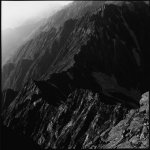Ben Z said:
My hat's off to anyone with the gumption to hike with an upper-level DSLR and "pro" lenses capable of really detailed landscape photos, or a medium-format outfit. I tried it years ago, at Bryce/Zion national parks and if I hadn't stuck my M4 and 35-50-90 in a small bag at the last moment I wouldn't have had any keepers from the trip. I hadn't noticed "hiking" around the camera store how quickly I would become exhausted carrying a Pentax 67, 4 lenses, a backpack large enough to hold it, and a tripod and head big enough to hold it steady. Especially with a few thousand feet of altitude thrown in the mix.
This past Sunday, I hauled my back country photo pack up some 4,000 vertical feet to 12,456 feet in just 4 miles, made it up in 1:53.
In just camera terms, the pack contained one 6x9 rangefinder, One Canon 5D, 16-35-II, 50 macro, extension tube, 85 1.8, flash, pocket wizard, spot meter, three batteries, 20GB in CF cards, 10 rolls of 220 Velvia, Gitzo medium carbon fiber. The whole thing weighed close to 36 LBS at launch with a full 100 OZ water bladder.
I don't use the dorky photo backpacks, can't put my Camelback bladder, clothes, avalanche equipment, bivy sack and all that more-important-than-photography stuff in it.
I spent over 6 hours at 12000 to 12,456 feet shooting stock.
I also use the light and fast as hell approach....I am really looking forward to the M8 helping in that role....


